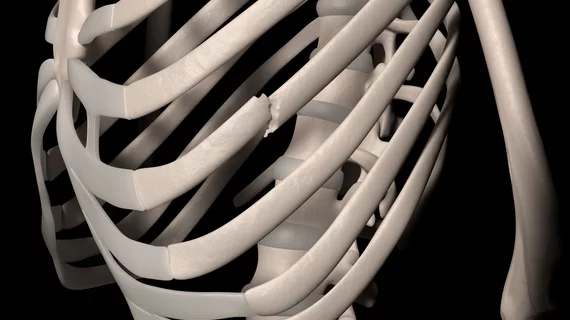Radiologists routinely underestimate severity of rib fractures on CT, trauma surgeons claim
Radiologists routinely underestimate the severity of rib fractures on CT, surgeons claim in a new single-center study published this month.
Chest computed tomography images are crucial to the treatment of such patients, particularly when they require surgical stabilization. Physician Zachary Bauman, DO, and co-authors hypothesized based on their own experience that there is a significant discrepancy between how surgeons and radiologists describe the number, patterns and severity of rib displacement. And their analysis — incorporating more than 400 patients treated at a level 1 trauma center and published in the Journal of Trauma and Acute Care Surgery — may add weight to those claims.
“Discrepancy exists between radiologist and surgeon regarding rib fracture description on chest CT as radiologists routinely underappreciate fracture severity,” Bauman, an assistant professor and critical care expert with the University of Nebraska Medical Center’s Department of Surgery, and colleagues concluded. “Surgeons need to evaluate CT scans themselves in order to appropriately decide management strategies and [surgical stabilization of rib fractures] indications,” they advised.
For their chart-review study, researchers retrospectively analyzed data from patients treated at UNMC between 2016-2017. A total of 410 subjects met the criteria, including 2,337 rib fractures with an average patient age of 56. Rib fracture descriptions were based on published standards of practice. They used a 1-5 scale, ranging from (1) nondisplaced to (2) minimal displacement (less than 50% of rib width), (3) severely displaced (greater than 50%), (4) bicortically displaced, or (5) “other.”
Compared to surgeons, radiologists “consistently underappreciated” rib fractures across all descriptive categories, Bauman et al. reported. Rads did not mention severity of displacement in about 35% of cases and missed nearly 6% of fractures (138) on the initial CT scan. Radiologists reported an average score of 1.58 compared to 1.78 by the surgeon, and physicians in imaging scored 55% sensitivity and 80% specificity when identifying severely displaced rib fractures.
Bauman and colleagues cautioned that their study has several limitations, including its retrospective, single-center nature and relatively small sample size. The investigation was also performed in an academic center, where many CTs are initially read by a radiology resident, though the final reports analyzed were those signed off by an attending. And there also appeared to be some variances in the taxonomy used by radiologist and surgeon when describing fractures. Bauman et al. posited that a more standardized classification approach between the two specialties could help alleviate some of these differences.
“Lastly, there is the issue of time constraint,” the authors wrote. “Radiologists have to review multiple images throughout the workday, evaluating several body regions, which is unlike the surgeon, who often has the time to examine a chest CT more carefully, especially if he or she is preparing for a [surgical stabilization of rib fractures]. From a radiologist standpoint, more detailed evaluation of a chest CT may not be practical with hundreds of CTs needing to be read throughout the day,” they theorized.

